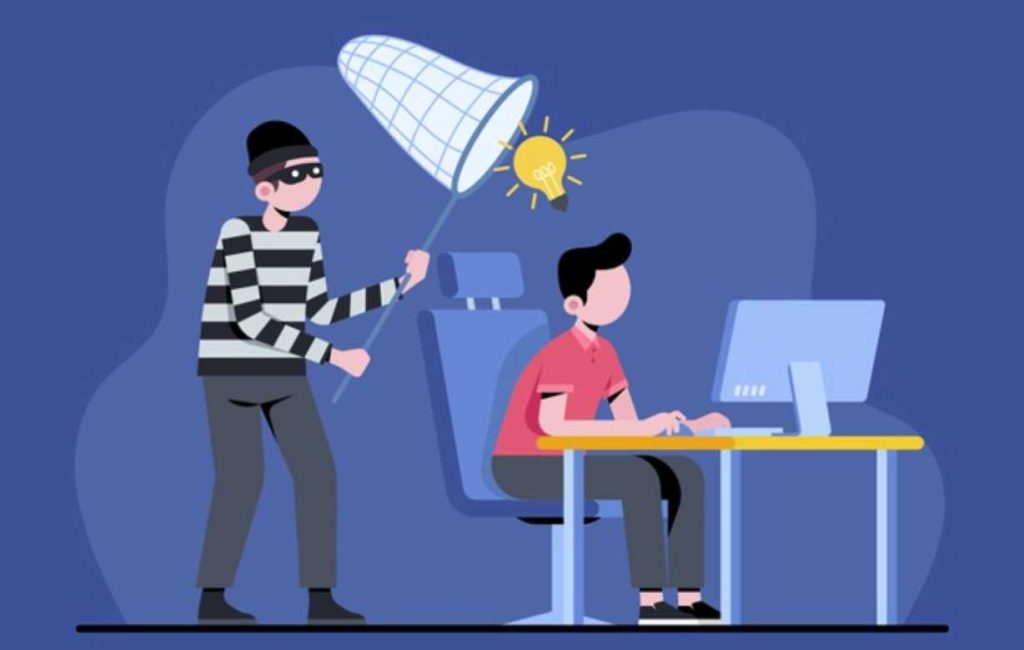Table of Content
Remember the Flappy Bird game app?
It was a widely celebrated fad of the year 2014. Although short-lived, when it peaked, its creator, Dong Nguyen, used to earn around US$50,000 per day from in-game advertising alone.
However, within a few weeks, Nguyen decided to withdraw the app from the app stores. The Flappy Bird fans were heavily disappointed, and many listed their smartphones installed with the game on eBay.
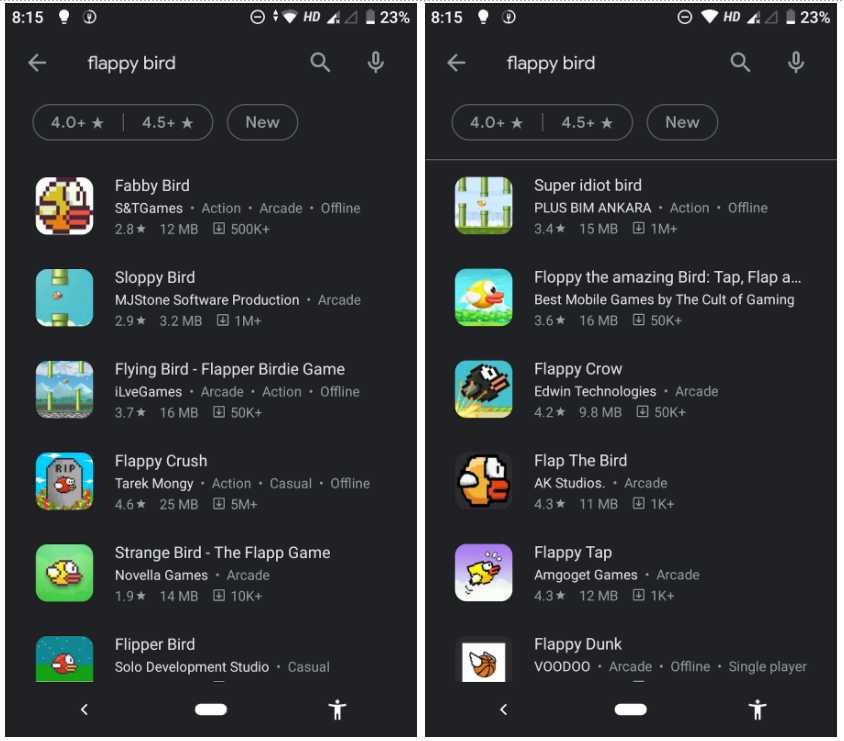
 The app store is flooded with Flappy Bird clones.
The app store is flooded with Flappy Bird clones.
Soon after its demise, the app stores were flooded with clones (and still are). If you were Flappy Bird’s creator and decided to trademark the app, none of the mobile app developers could have cloned your creation without facing unfavourable legal repercussions, or let alone monetized it.
By registering a trademark, you can secure your app and eradicate the circumstances of someone else profiting from your creation.
In definition, a trademark is a word, symbol, phrase, or design that distinguishes or identifies the source of products or services of one entity from those of others. This means trademarks help in assuring customers that a particular product (or service) can only come from you and no one else.
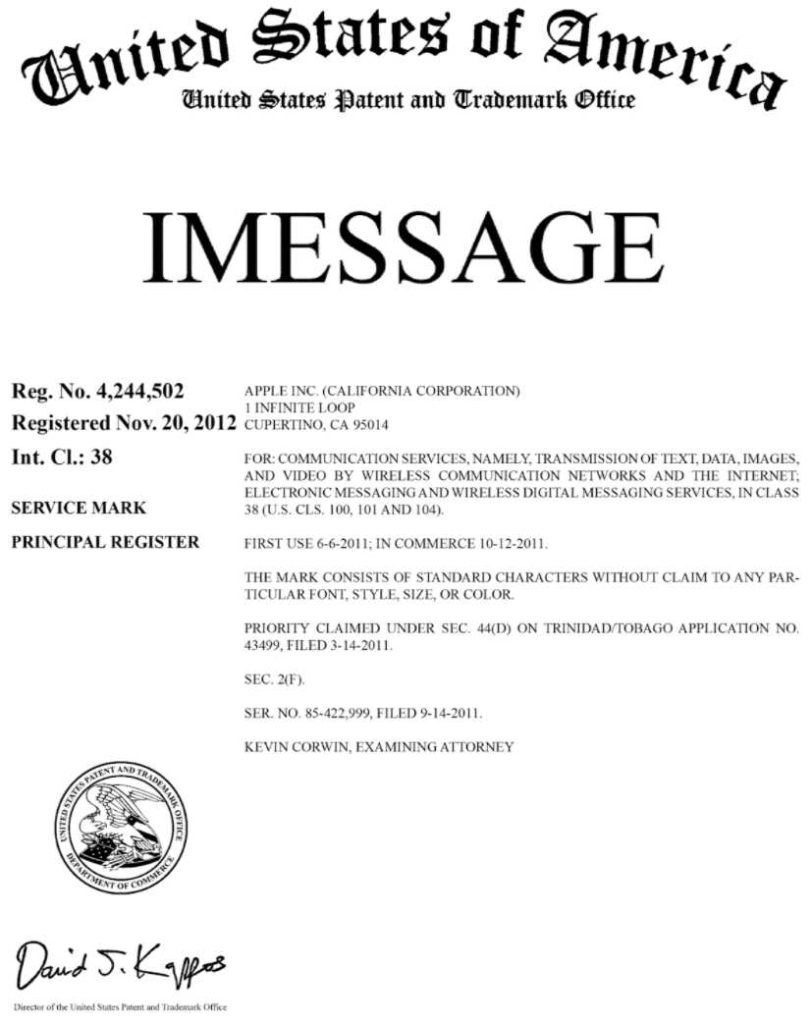 The trademark certificate of iMessage by USPTO. Image Credit: idownloadblog.com
The trademark certificate of iMessage by USPTO. Image Credit: idownloadblog.com
In a simpler sense, a trademark is a brand. It helps customers to distinguish your products (or services) from competitors. So while browsing for a product, customers might identify a company’s trademark (brand name and logo) and buy its product due to past experiences.
In the context of mobile applications, elements such as logos, slogans, brand names, and app UI design elements and sounds come under trademarking.
But suppose you’re creating an enterprise mobile app (with the basic features) that lets a company track their employees’ attendance and performance. In that case, there aren’t many components that could be trademarked, and so, it may not be worth the hassle.
We’ll discuss more on whether you should trademark an app or not in a bit.
Copyright vs Trademark vs Patent: How Are They Different?
Trademark is a kind of intellectual property rights (IP rights). If you’re an app developer, along with trademark, you also need to know about the other two types of IP rights – copyright and patent.
Each type of IP right protects different aspects of your business, and in this case, your mobile app. And yes, trademarks are different from copyrights or patents. To make things clear, let’s take a look at how they differ and what assets they protect.
Copyright
 A copyright certificate. Image Credit: helensedwick.com
A copyright certificate. Image Credit: helensedwick.com
Copyright, denoted by the symbol ©, protects original artistic and literary works such as images, music, books, computer software and movies. So, if you create an advertisement as part of your app marketing strategy, you can copyright it and limit anyone else from using it.
Also, if you develop an augmented reality app that lets a user view the Sistine Chapel and the paintings made by Michelangelo, you can copyright the AR content and protect your hard work.
In the United States, copyrights are granted by the U.S. Copyright Office. The duration of protection depends on the nature of copyright.
If the copyright is for the works of an individual, protection lasts for the lifetime of the individual plus 70 years. Works that are created anonymously, pseudonymously, or by hiring professionals, the protection of copyright lasts for 95 years from the point of publication or 120 years from the date of creation – whichever is shorter.
Trademark
A trademark is a form of branding used on goods and services. As previously mentioned, a trademark lets you protect:
- Words (Brand names)
- Phrases (Slogans)
- Symbol (App icon design)
- UI/UX design elements
- Sounds
In the United States, trademarks are granted by the United States Patent and Trademark Office (USPTO).
Unlike copyrights or patents, trademarks don’t expire after a predefined number of years. As long as you pay the fees at regular intervals and file the maintenance documents, the trademark registration can last forever.
You can trademark app name and its icon to make sure no one else uses it. Also, unlike copyright, trademark infringement doesn’t require someone to copy the UI/UX design element directly to cause the infringement.
Instead, it becomes an infringement if someone designs an element that is similar enough to cause confusion due to similarity – meaning, trademarks will help in protecting your app components from cloning (like in the Flappy Bird instance) or even if someone uses an app name or logo similar to your app that can cause confusion (due to similarities) to the user.
Patent
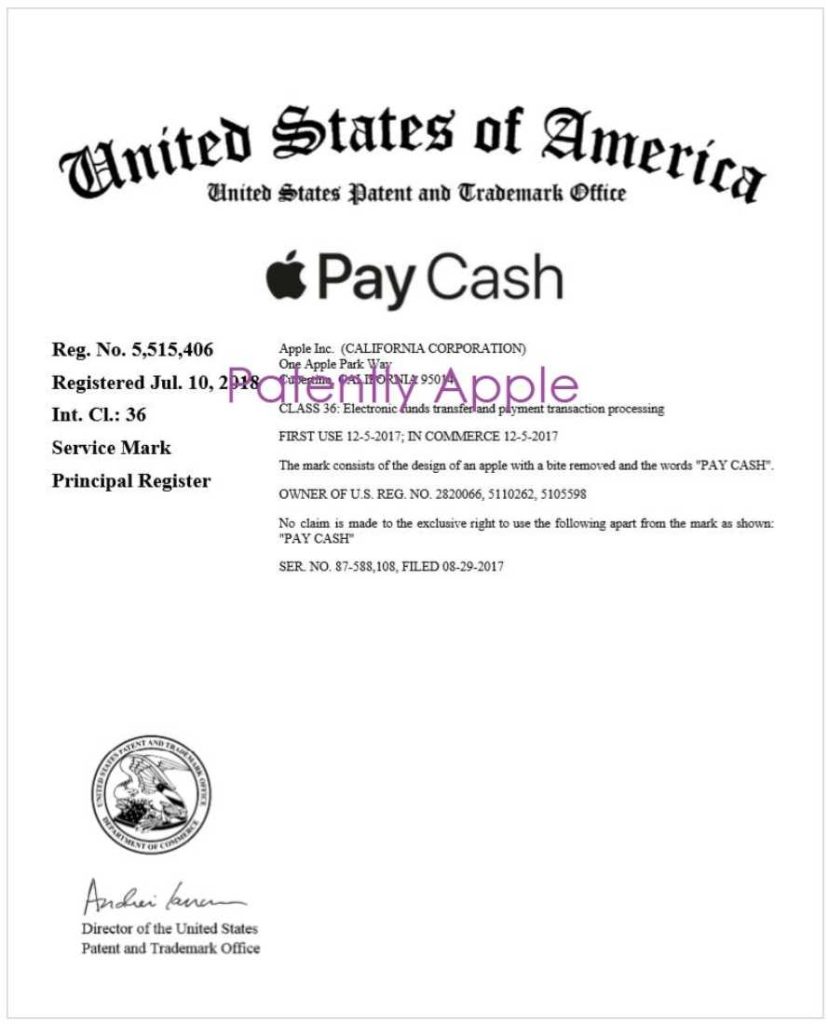 Patent certificate for Apple Pay. Image Credit: patentlyapple.com
Patent certificate for Apple Pay. Image Credit: patentlyapple.com
A patent generally protects inventions. It is an exclusive right awarded to inventors of a product or process by the government – giving the inventor legal powers to sue anyone who uses, copies, or sells their invention, without their consent, for a certain number of years.
In the United States, patents are granted by the United States Patent and Trademark Office (USPTO).
According to the laws of the US government, a patent can last for up to 20 years from the date of filing. Products or processes offering a new technical solution to a problem or represent a novel method of doing something is patentable. Also, patents follow a first-to-file system and not a first-to-invent system.
If you’d like to know more about patenting your app and whether it’s worth doing so, check out our guide on how to patent an app.
One of the best examples of patent wars in the smartphone realm is between Apple and Samsung. The patent infringement case that was most discussed was regarding the “Slide to unlock” feature – which was patented by Apple.
 The “Slide to unlock” feature patent by Apple. Image Credit: appleinsider.com
The “Slide to unlock” feature patent by Apple. Image Credit: appleinsider.com
According to Samsung – who was accused of copying the user interface property “Slide to unlock” and some other patented features from Apple – the patented features were “too obvious” and so, need not be patented.
Even though the initial demand made by Apple for the infringement was US$2.2 billion, the case took a few years to be solved and was finally settled at $US120 million.
Interestingly, Apple’s “Slide to unlock” patent was invalidated by the German court in 2013 when the US tech giant went against Motorola. According to the court, Apple’s patent was somewhat “irrelevant” as numerous manufacturers have already implemented the unlock functionality with similar design workarounds.
Why Trademark Apps?
1. It Protects You From Trademark Trolling
Some individuals, known as trademark trolls, have the habit of registering trademarks and not publicly disclosing it to demand compensation or claim damages when someone uses it. To make sure you don’t fall prey for such frauds, trademarking app names and logos is highly recommended.
Even if you were the first person to use a name and forgot to trademark it, someone else can register it later and sue you for using it.
2. It Gives Users More Assurance to the Users
Trademarks can be considered as a component for product quality assurance. A trademarked app or logo means no other developer (other than you) can publish apps under the same banner. This will give more confidence to users regarding the quality of an app and give users more reasons to try out different apps from the same developers.
3. You Can Use It as a Collateral
Since a trademark is a type of IP right, you can use it as collateral while availing loans.
4. You Can Profit From It
Suppose you trademark an app and decide to not go further with it, you can always transfer the IP rights under a license agreement and profit from it.
Things to Consider Before You Trademark Apps
1. Trademarks Don’t Protect Your App as a Whole
Trademarks don’t protect your app source code. Instead, only certain components like the app name, logo, UI/UX elements or an in-game fictional character (in some instances) can be trademarked.
This also means that, if someone copies your app’s functionality and publishes it with a different name, it won’t be considered a trademark infringement.
An app component can be registered as a trademark only if you’re planning to use it as a trademark – meaning, the component being trademarked must be used in connection with the sale of the product.
In terms of mobile applications, this means that the app component you wish to trademark must be associated with the mobile application in such a way that the individual installing the app must be aware of the relationship between the trademark and app.
To make things more clear, consider the game app Super Mario Run. The protagonist, Mario, is a fictional character trademarked by Nintendo as the character is extensively used for branding (in the form of name and logo).
 Mario is a trademarked character by Nintendo. Image Credit: uspto.gov
Mario is a trademarked character by Nintendo. Image Credit: uspto.gov
Any individual installing the app can use the character, Mario, as a way to recognise the app and the brand, and so, is an excellent example of an in-app element that can be trademarked.
In the same way, something as ubiquitous as the hamburger menu or an in-app navigation element which isn’t used for branding the app can’t be trademarked. However, app names or logos (for example, the Gmail envelope design) can be trademarked.
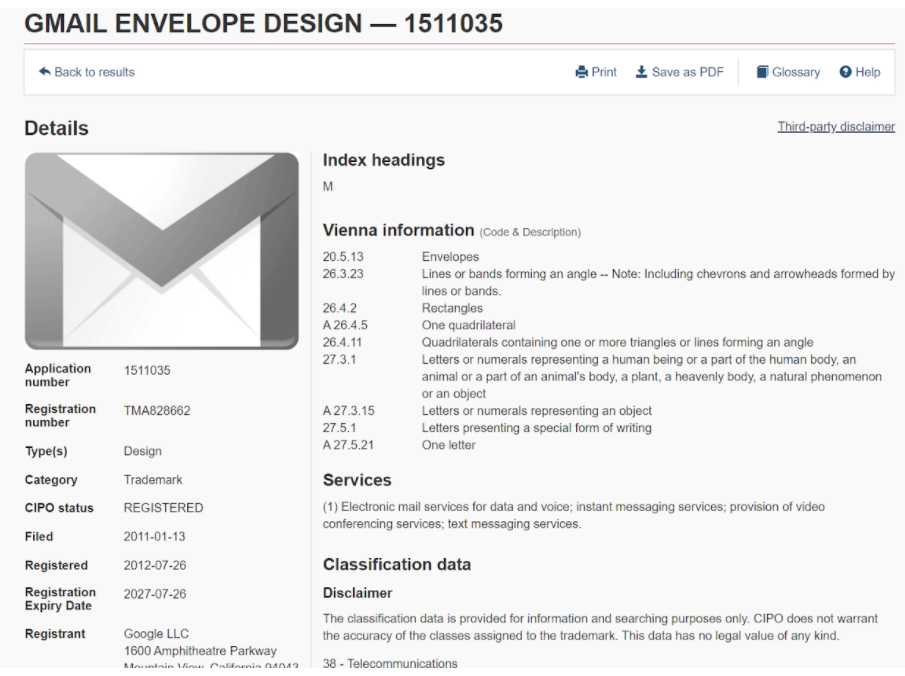 The trademark details of the Gmail Envelope Design.
The trademark details of the Gmail Envelope Design.
2. Not All Trademarks Are Registered
Registration isn’t mandatory for trademarks. Instead, you can establish “common law” rights in a trademark for its use in commerce. Checkout Basic Facts About Trademarks Booklet from USPTO to know more about common law trademark rights.
However, you won’t have the protection that a federal registration with the USPTO offers. Also, you won’t have the exclusive right to use the mark – meaning, you won’t have full rights to stop someone from using the mark.
 Registered and unregistered trademark symbols. Image Credit: keydifferences.com
Registered and unregistered trademark symbols. Image Credit: keydifferences.com
If you’re using an unregistered trademark, you need to use the ™ symbol. If it’s a registered mark, you can use the ® symbol. Also, the ™ symbol doesn’t necessarily mean that the trademark application is being processed.
3. You Can Choose Between Colour Logo and B&W
If you’re applying for a trademark for a coloured logo, it will be granted only for that specific colour combination. Down the lane, if you plan to change the colour scheme, the new combination won’t be protected, and you will have to file a new registration application.
However, if you opt for a black and white logo, the logo pattern is trademarked without any specific colours – meaning, you can change the colour scheme as you wish and maintain the protection.
4. Don’t Forget to Include the User Date
In some countries, the user date in the application specifies the data since when the mark is being used in commerce. This is extremely important to acquire the trademark registration in the event two similar applications are filed.
Irrespective of the business turnover, scale or date of application, the applicant claiming an earlier user date gets priority over the other applicant.
How to Trademark an App?
Here are the critical steps you need to follow to file a trademark application for your mobile app.
1. Come up With an Original App Name and Logo
Since the app’s name will be one of those components you’re planning to trademark, you need to make sure it is unique, not used by any other developers, and simple enough for the users to remember.
However, if the app name is generic, the USPTO is less likely to allow you to trademark it. For example, you can’t trademark app names such as “online video converter” as the phrase will always remind users about the service and rarely about an app.
App names that are rarely used in natural conversation or are new words that combine multiple words stand a good chance of being approved. If the app name doesn’t at all reveal what your app does (for example, Google Duo gives out no clue it’s a video calling app), then you’re more likely to get a trademark for it.
The same applies to app logos. They must be unique; otherwise, even a near resemblance to an existing app logo can put your application in jeopardy.
2. Make a List of Items You Wish to Trademark
As previously mentioned, not all app components can be trademarked. The element that you wish to trademark must uniquely identify your app and must also be visible to the user while installing it. In that sense, the app name, logo, and fictional characters being used as app icons are the best components to be trademarked.
3. Check Whether You Can Register Them
If someone else has registered the trademark before, you won’t be able to trademark the app component. Of course, checking out the app name on Google or the app stores might give you some idea whether it’s used by someone else.
But many trademarks may not be publicly disclosed, and so, you need to dig deeper. To check whether the component you’re planning to trademark is available, you can head to Trademark Electronic Search System (TESS) of USPTO.
Before that, keep in mind that there are 45 trademark classifications. App developers usually select class 9 as it’s related to software programs. You need to choose other classes depending on your app’s functionality. For example, if your app provides any medical function, you can consider class 44, which is related to medical services.
Also creating a strategy will streamline the search process. To know more about creating a successful strategy, check out the search strategy section of USPTO.
4. Find Out Your Jurisdiction
List down all the countries in which you want to protect your app. However, acquiring trademarks in multiple countries can be expensive.
Instead, choose the essential markets based on your target audience. For example, if your app targets teens of the United States, obtaining trademark registration from USPTO will make more sense.
You can always acquire trademark registrations in other countries once your app starts getting popular. You can also check out the Madrid System to apply for protection in up to 123 countries with a single set of fees.
5. Contact a Trademark Attorney
The processes for trademarking an app can be time-consuming and monotonous. If you’re a mobile app developer, you’ll have to invest a considerable amount of time – which you actually can use in improving your app.
If you contact a trademark attorney, all you’ll have to do is submit the required documents and pay the fees. A trademark attorney will exactly know what, where, and how to search for. They will also have specialised tools to fasten the entire process and tested tricks to improve the success rate of approval.
6. File the Trademark Application
Once you have the required documents and have confirmed that the component can be trademarked, you can apply online on USPTO’s website. Once you have submitted your application, the trademark review process will take around six to eight months.
7. Lookout for Infringement
Once your trademark application is approved, you can confidently distribute your app and worry the least about someone using the app name or logo. Once you have published your app, keep an eye on the results that come up while searching for your app. The majority of app distribution channels will assist you in removing the infringing apps.
In Conclusion
Trademarking an app can be a tedious process. Not only will it be time-consuming, but depending on the number of components you wish to trademark and their classes, the process can be incredibly expensive.
However, if you’re planning to build a mobile application with the potential to disrupt the industry, bearing the hassle of trademarking will help you in the long run. With a registered trademark, your hard work is protected by law, and no one can misuse your brand identity.
Related Sources to Read:
–When to Consider Mobile App Development for Your Business
–Why Mobile Apps Are Important for Your Business
–Factors to Consider When Hiring a Mobile App Development Company
–Mobile App Development Cost Estimate in Malaysia
If you’re looking for a top-notch Mobile App Developer, your search ends here! One of the renowned Mobile App Developer in Malaysia has what it takes to bring your mobile app ideas come to life and produce results.

